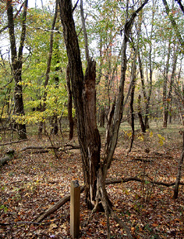Even though this forest is certainly not considered “old growth,” there is a large amount of dead woody debris here.
Trees die for a variety of reasons, including disease, and insect and storm damage. In addition, wind frequently prunes dead branches from an otherwise live tree. Bacteria, fungi and insects quickly attack all of this woody debris on the forest floor. These organisms absorb nutrients that had previously been locked up in wood, recycling them back into the forest food chain. Dead branches also provide structural diversity to the forest, providing shelter to animals like salamanders, sowbugs and worms.
Trees that die but remain upright are called snags. Snags do begin to decay as bacteria, insects and fungi colonize the upright trunk, but the rate is comparatively slow. Snags are especially valuable as nest sites for owls and flying squirrels, and woodpeckers, creepers and other gleaning birds profit from the rich lode of insects. Although we humans tend to view logs, branches and snags as untidy, they are very important to the ecology of a forest.
Japanese barberry is a spiny shrub found along the trail that grows bright red berries over that summer that it keeps throughout the winter. Originally imported to the United States in 1875, this was historically planted as living fences for livestock. Now this plant is considered invasive and grows as dense thickets that can crowd out native low-growing plants. It’s dense branches also create an ideal humid environment for deer ticks, a parasitic arachnid known for carrying the pathogen that causes Lyme disease.
